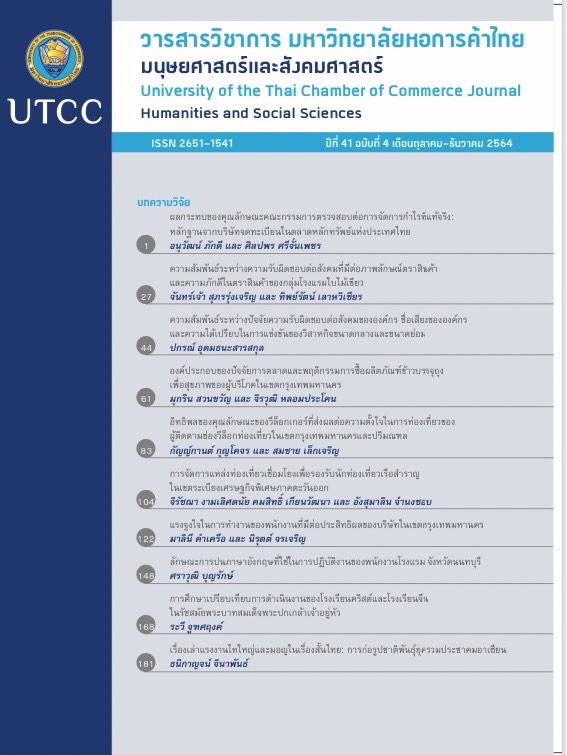English Code Mixing Characteristics in Working of Hotel Personnel in Nonthaburi Province
Main Article Content
Abstract
This research has covered four main focuses; including firstly to analyze the characteristics of English code-mixing in working of hotel personnel, secondly to compare the code-mixing used in listening, speaking, reading, and writing at work, thirdly to study the levels of attitude towards English code-mixing in working of hotel personnel and lastly to gather the recommendations in English code-mixing usage of hotel personnel. The participants were 50 front office personnel who work in Pak Kret District of Nonthaburi Province. The study adopted several research instruments; a structured interview, attitude questionnaire, and code-mixing table. The statistics used were a frequency distribution, percentage, mean, and standard deviation. The results revealed 764 code-mixing sentences which mostly found in 444 simple sentences, 317 affirmative sentences, 253 nouns, and 162 noun phrases, while 132 words were mostly used in dealing with complaints and 107 initials were mostly found in documents and diary at work. The comparison of English code-mixing used at work were also mostly found in speaking. The results also reveal that the levels of attitude were found at a high level (x̅ = 3.98, S.D. = 0.94) while the hotel personnel recommended that abbreviation should be understood clearly between the sender and the receiver. The explanation of code-mixing usage should be introduced to novice staff.
Article Details

This work is licensed under a Creative Commons Attribution-NonCommercial-NoDerivatives 4.0 International License.
ลิขสิทธิ์ของบทความ
ผลงานที่ได้รับการตีพิมพ์ถือเป็นลิขสิทธิ์ของมหาวิทยาลัยหอการค้าไทย ห้ามมิให้นำเนื้อหา ทัศนะ หรือข้อคิดเห็นใด ๆ ของผลงานไปทำซ้ำ ดัดแปลง หรือเผยแพร่ ไม่ว่าทั้งหมดหรือบางส่วนโดยไม่ได้รับอนุญาตเป็นลายลักษณ์อักษรจากมหาวิทยาลัยหอการค้าไทยก่อน
References
จิราภรณ์ กาแก้ว. (2553). รายงานการวิจัย การศึกษาทัศนคติ คำ และสำนวนภาษาอังกฤษปนภาษาไทยในรายการโทรทัศน์ผ่านระบบเครือข่ายสารสนเทศในปัจจุบัน.นครปฐม: มหาวิทยาลัยเกษตรศาสตร์.
ชำนาญ ศุภนิตย์ และสุทิน พูลสวัสดิ์. (2558). รวมหลักไวยากรณ์อังกฤษฉบับสมบูรณ์ (พิมพ์ครั้งที่ 8). กรุงเทพฯ: ซีเอ็ดยูเคชั่น.
ธีรวิทย์ ภิโญณัฐการต์. (2554). ไวยากรณ์ภาษาอังกฤษตามแนวภาษาศาสตร์.นครราชสีมา: มหาวิทยาลัยเทคโนโลยีสุรนารี, สาขาวิชาภาษาอังกฤษ, สำนักวิชา เทคโนโลยีสังคม.
นภัสสรณ์ นาคแก้ว. (2556). การปนภาษาอังกฤษในภาษาไทย: กรณีศึกษา รายการเทยเที่ยวไทย (การค้นคว้าอิสระ ปริญญามหาบัณฑิต). มหาวิทยาลัยศิลปากร, กรุงเทพฯ.
นัฐยา บุญกองแสน. (2542). การปนภาษาอังกฤษในภาษาไทยกับทัศนคติทางภาษาของบุคคลต่างชั้นอาชีพ (วิทยานิพนธ์ปริญญามหาบัณฑิต ไม่ได้ตีพิมพ์). จุฬาลงกรณ์มหาวิทยาลัย. กรุงเทพฯ.
ปรารถนา กาลเนาวกุล. (2544). รายงานการวิจัย การปนภาษาอังกฤษในภาษาไทยของรายการโทรทัศน์: ลักษณะ ทัศนคติ การรับรู้และแรงจูงใจ. ปัตตานี : มหาวิทยาลัยสงขลานครินทร์.
พรรณทิวา อินต๊ะ. (2555). การปนภาษาอังกฤษในนิตยสารภาษาไทย. พิฆเนศวร์สาร,8(1), 33-42.
วิภา ฌานวังศะ. (2548). Beginning with the foundation. ใน มหาวิทยาลัยสุโขทัยธรรมาธิราช,สาขาวิชาศิลปศาสตร์, เอกสารการสอนชุดวิชา การเขียนภาษาอังกฤษ หน่วยที่ 1-5 (พิมพ์ครั้งที่ 11) (น. 57-68). นนทบุรี: มหาวิทยาลัยสุโขทัยธรรมมาธิราช.
ศยามล ไทรหาญ. (2553). การปนภาษาอังกฤษในภาษาไทยในนิตยสารวัยรุ่น (วิทยานิพนธ์ปริญญามหาบัณฑิต ไม่ได้ตีพิมพ์). มหาวิทยาลัยเกษตรศาสตร์, กรุงเทพฯ.
สุธิวงศ์ พงศ์ไพบูลย์. (2544). หลักภาษาไทย (พิมพ์ครั้งที่ 16). กรุงเทพฯ: ไทยวัฒนาพานิช.
อนุวัต ชัยเกียรติธรรม. (2561). รายงานการวิจัย การวิเคราะห์หลักการปนภาษาในการทำงานของบุคลากรโรงพยาบาลส่งเสริมสุขภาพตำบล จังหวัดมหาสารคาม. มหาสารคาม: มหาวิทยาลัยราชภัฏมหาสารคาม.
Kavaliauskienë, G. (2009). Role of mother tongue in learning English for specific purposes. ESP World, 8(1), 2-8. Retrieved from http://www.philologician.com/Articles_22/PDF/issue_22.pdf
Marzona, Y. (2017). The use of code mixing between Indonesian and English in Indonesian advertisement of GADIS. Jurnal Ilmiah Langue and Parole, 1(1),238-248.
Neely, J. (2017, Auguse 29). Improving active listening skills at the Workplace [Weblogmessage]. Retrieved from https://toggl.com/blog/active-listening-skills
Ransom, A. (2020). Common hospitality acronyms defined [Weblog message]. Retrieved from https://www.amadeus-hospitality.com/insight/common-hospitality-acronyms-defined/
Wardhaugh, R. (1986). An introduction to Sociolinguistics. Oxford: Basil Blackwell.
Yuliyawati, S. N. & Bakhti, K. Y. (2018). The use of the Indonesian-Arabic code mixing in business names found on Jalan Cisarua Puncak, Bogor. International Journal of Language and Linguistics, 5(1), 25-37.


